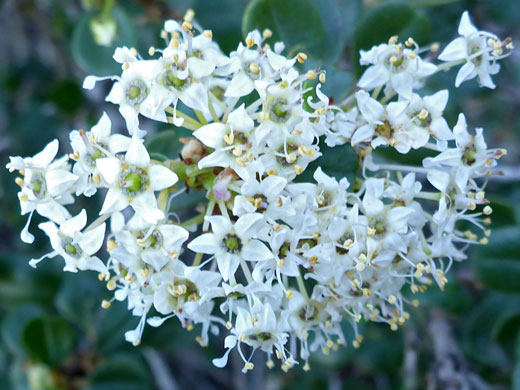Ceanothus Verrucosus, Wart-Stemmed Ceanothus
Plants > Wildflowers > Rhamnaceae > Ceanothus Verrucosus
Common names:
Wart-stemmed ceanothus, barranca brush
Family:
Scientific name:
Ceanothus verrucosus
Main flower color:
Range:
Far southwestern California
Height:
Up to 9 feet
Habitat:
Chaparral, coastal bluffs, pine woods, from near sea level to 1,500 feet
Leaves:
Alternate, obovate to nearly round, up to 0.5 inches long, margins entire to finely toothed
Season:
January to April
Ceanothus verrucosus is a small to medium-sized shrub, with woody branches and shiny, hairless leaves. New branches are finely hairy. Leaves are bright green and hairless above, duller and finely hairy below. Leaf margins may be entire or lined with up to 16 small, sharp teeth. Leaf tips are flat or slightly rounded or very shallowly notched. Leaves have knob-like stipules at the base of the short petioles, hence the common name of wart-stemmed ceanothus.
The inflorescence is a dense umbel, individual flowers attached by whitish pedicels. Flowers have a relatively long, slender nectary tube, a disc-like hypanthium, five white sepals, and five hooded white petals.Sepals and petals are all of similar length. There are five stamens positioned opposite the petals, with white filaments and light brown anthers, and a greenish ovary at the center, with three styles.
The inflorescence is a dense umbel, individual flowers attached by whitish pedicels. Flowers have a relatively long, slender nectary tube, a disc-like hypanthium, five white sepals, and five hooded white petals.Sepals and petals are all of similar length. There are five stamens positioned opposite the petals, with white filaments and light brown anthers, and a greenish ovary at the center, with three styles.
All Contents © Copyright The American Southwest | Comments and Questions | Contribute | Site Map



